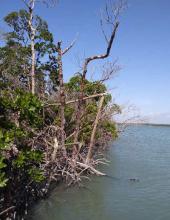
Abstract
In September of 2017, Hurricane Irma made landfall within the Rookery Bay National Estuarine Research Reserve of southwest Florida (USA) as a category 3 storm with winds in excess of 200 km h-1. We mapped the extent of the hurricane ’s impact on coastal land cover with a seasonal time series of satellite imagery. Very high-resolution (i.e. 5 meter pixel) satellite imagery has proven effective to map wetland ecosystems, but challenges in data acquisition and storage, algorithm training, and image processing have prevented large-scale and time-series mapping of these data. We describe our approach to address these issues to evaluate Rookery Bay ecosystem damage and recovery using 91 WorldView-2 satellite images collected between 2010 and 2018 mapped using automated techniques and validated with a field campaign. Land cover was classified seasonally at 2 meter resolution (i.e., healthy mangrove, degraded mangrove, upland, soil, and water) with an overall accuracy of 82%. Digital change detection methods show that hurricane-related degradation was 17% of mangrove forest (~5 km2). Approximately 35% (1.7 km2) of this loss recovered one year after Hurricane Irma. The approach completed the mapping approximately 200 times faster than existing methods, illustrating the ease with which regional high-resolution mapping may be accomplished efficiently.
About this article
This paper, published in Remote Sensing in 2020, describes the results of a Science Collaborative project that refined and piloted the use of satellite-based habitat mapping at Rookery Bay NERR in southwest Florida.
McCarthy, M.; Jessen, B.; Barry, M.; Figueroa, M.; McIntosh, J.; Murray, T.; Schmid, J.; Muller-Karger, F.E. Automated High-Resolution Time Series Mapping of Mangrove Forests Damaged by Hurricane Irma in Southwest Florida. Remote Sens. 2020, 12, 1740. Available at: https://doi.org/10.3390/rs12111740